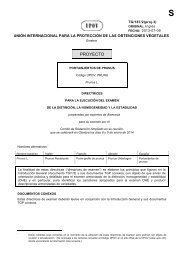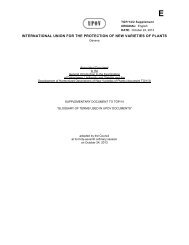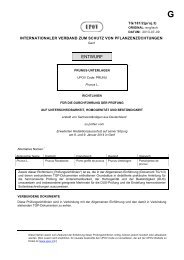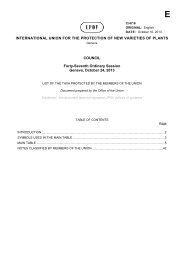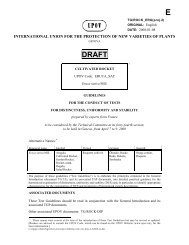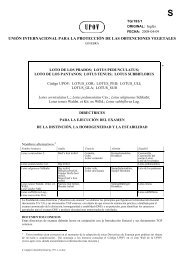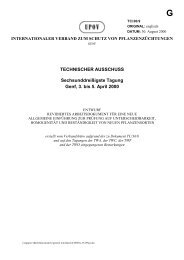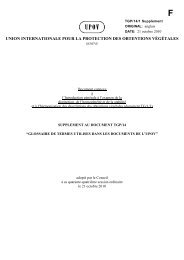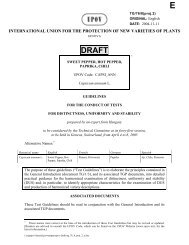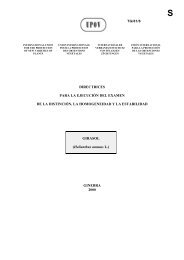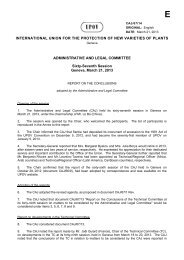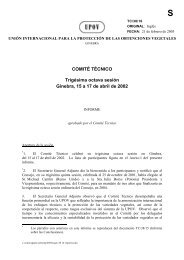E - International Union for the Protection of New Varieties of Plants
E - International Union for the Protection of New Varieties of Plants
E - International Union for the Protection of New Varieties of Plants
Create successful ePaper yourself
Turn your PDF publications into a flip-book with our unique Google optimized e-Paper software.
TGP/14/1: Section 2: Botanical Terms<br />
Subsection 2: Shapes and Structures: III. DEFINITIONS FOR SHAPE AND STRUCTURE TERMS<br />
page 71<br />
Term<br />
Smooth<br />
Spadix<br />
Sparse<br />
Spathulate<br />
Spatulate<br />
Spheric<br />
Spike<br />
Spine<br />
Spinose (Spiny,<br />
Thorny)<br />
Spiral<br />
Spreading<br />
Spur Type<br />
Squamose<br />
Square<br />
Stalked<br />
Stance<br />
Star-shaped<br />
Stellate<br />
Stipitate<br />
Stoloniferous<br />
Striate<br />
Strigose<br />
Subulate<br />
Symmetric<br />
Sympetalous<br />
Terete<br />
Definition / comment<br />
‘repand’ which is shallowly ‘sinuate’ and ‘undulate’ which is wavy perpendicular<br />
to <strong>the</strong> plane <strong>of</strong> <strong>the</strong> plant part.<br />
Even; opposite <strong>of</strong> rough. For internal texture characteristics <strong>the</strong> term ‘fine’ is used.<br />
a spike <strong>of</strong> flowers densely arranged around it, enclosed or accompanied by a<br />
highly specialized bract called a spa<strong>the</strong>. It is characteristic <strong>of</strong> <strong>the</strong> Araceae family.<br />
Few per unit area, as opposed to ‘dense’. The term “open” is used to describe<br />
plants with sparse branches or foliage.<br />
use ‘spatulate’.<br />
Spoon-shaped; attenuate at <strong>the</strong> base and rounded at <strong>the</strong> apex. Compare ‘clawed’<br />
(‘unguiculate’) which narrows more abruptly towards <strong>the</strong> base.<br />
use ‘Globose’<br />
a type <strong>of</strong> raceme with flowers that do not have a pedicel<br />
A rigid, sharply pointed modified organ or part <strong>of</strong> an organ e.g. a modified stem or<br />
reduced branch, leaf, stipule, etc. Contains superficial as well as deeper layers.<br />
Compare ‘prickle’ which arises from <strong>the</strong> superficial layers only and ‘thorn’ which<br />
can be used synonymously to ‘spine’ but normally applies to modified stems only.<br />
Bearing spines; with stiff, sharp projections from <strong>the</strong> superficial and deeper layers<br />
<strong>of</strong> <strong>the</strong> plant part. Compare ‘aculeate’ (only from <strong>the</strong> superficial layers).<br />
Corkscrew-shaped; <strong>the</strong> circumference even or diminishing.<br />
Directed outwards; e.g. branches diverging. Also applies to growth habit.<br />
Plant habit in which <strong>the</strong> shoot internodes are very short. Found in some fruit<br />
varieties.<br />
Scaly; with minute adpressed scales.<br />
Equilaterally quadrangular or rectangular; with <strong>the</strong> length and <strong>the</strong> width having <strong>the</strong><br />
same dimensions. Length/width ratio 1:1. Forms part <strong>of</strong> <strong>the</strong> ‘oblong’ series.<br />
Attached to <strong>the</strong> supporting plant by a stalk. Compare ‘sessile’ and ‘pedicelled’.<br />
use ‘attitude’<br />
use ‘stellate’<br />
Star-shaped: with several points radiating from <strong>the</strong> center<br />
use ‘stalked’.<br />
Bearing prostrate stems rooting at <strong>the</strong> nodes or at <strong>the</strong> tips, producing new plants.<br />
Compare ‘procumbent’ not rooting at <strong>the</strong> nodes.<br />
Finely striped; with more or less parallel lines <strong>of</strong> a different color, or grooves or<br />
ridges. Compare ‘aciculate’ (needle scratches in different directions).<br />
Covered by <strong>the</strong> general term “hair” in <strong>the</strong> Test Guidelines. With stiff, sharp,<br />
coarse, adpressed, bristly trichomes, <strong>of</strong>ten swollen at <strong>the</strong> base. Compare ‘setose’<br />
with erect trichomes.<br />
Awl-shaped; tapering from a narrow base to a fine, sharp point.<br />
Being capable <strong>of</strong> median division into two equal halves, at least along <strong>the</strong><br />
longitudinal axis. Compare ‘asymmetric’, ‘actinomorphic’.<br />
With petals fused, at least partly, into a corolla tube. Compare ‘apopetalous’.<br />
Long and slender, tapering towards <strong>the</strong> apex, circular in transverse section.



